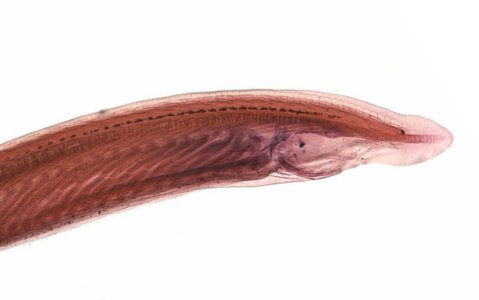Ancient ancestor gives insight into evolution

A small marine animal that spends most of its life buried in the sand is unwittingly helping scientists understand the evolution of humans.
The tiny creature is enabling scientists at the University of St Andrews to piece together the ancestral starting point from which it and humans evolved, despite this ancestor having lived 550 million years ago.
The St Andrews’ researchers are part of an international team that has successfully sequenced the genome of the Florida lancelet, a 4cm long invertebrate said to resemble a filleted anchovy.
The new study of the lancelet (or amphioxus, Branchiostoma floridae), provides a major advance in understanding the evolution of humans and their fellow vertebrates. A close relative of backbone possessing vertebrates, amphioxus provides deeper understanding of the crucial steps in the evolution of vertebrate and human genomes.
Dr David Ferrier of the Gatty Marine Laboratory at St Andrews led the Scottish team within the international network of researchers that made the precise organisation of the invertebrate’s genome clear for the first time. The genome was sequenced at the Joint Genome Institute in the US, while Dr Ferrier’s group analysed specific parts of the genome responsible for controlling important aspects of animal developmental biology.
Dr Ferrier said, “The amphioxus genome sequence – the genetic material encoded by the organisms’ DNA – provides an important insight into how the group of animals that contains humans, birds and fish evolved.
“By working out the genome sequence of this closely related invertebrate, it has been possible to reconstruct large elements of the genome of the ancestor from which vertebrates like ourselves arose.
“We can see where the sorts of genetic networks that build organs like the brain, kidney, pancreas and pituitary came from, and how the genes that make up our immune system, build our nerves, skeleton and hormonal systems arose.”
Adult amphioxus are about 4-6cm long, beige in colour, and spend most of their lives buried in the seabed with just their head protruding. Pointed at both ends (hence the common name lancelet), its head is distinguishable by the small feeding tentacles around the mouth. Scientists think its appearance has probably not changed drastically for over 500m years.
“The importance of the amphioxus genome lies in the fact that amphioxus is descended from the earliest lineage of chordates – the group of animals to which we all belong – and so is of immense value in understanding what the last common ancestor of this important group of animals was like,” explained Dr Ferrier.
“The careful comparisons between the amphioxus and human genomes gives us a much better understanding of how the human genome arose.
“By these sorts of genome comparisons we can reconstruct the genomes of ancestors that went extinct over 550 million years ago, which were the starting point for the evolution of the incredible diversity in the animal kingdom that we now see today,” he concluded.
The St Andrews research is funded by the BBSRC (Biotechnology and Biological Sciences Research Council) and published in the current issue of Nature and online at Genome Research.
ENDS
NOTE TO EDITORS:
DR FERRIER IS AVAILABLE FOR INTERVIEW ON 01334 463480 / MOBILE 07990544489, EMAIL [email protected]
NOTE TO PICTURE EDITORS:
AN IMAGE OF THE FLORIDA LANCELET IS AVAILABLE FROM THE PRESS OFFICE – CONTACTS BELOW.
CAPTION: A stained head-end of an amphioxus juvenile, photographed by Dr David Ferrier from a slide in the Cole collection in the Cole Museum of Zoology (University of Reading).
Issued by the Press Office, University of St Andrews
Contact Gayle Cook, Press Officer on 01334 467227 / 462529, mobile 07900 050 103, or email [email protected]
Ref: animal evolution 190608
View the latest University press releases at www.st-andrews.ac.uk
Category Research